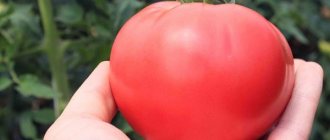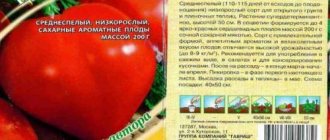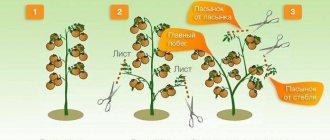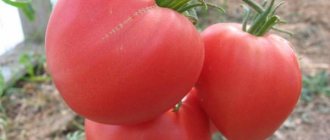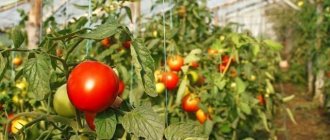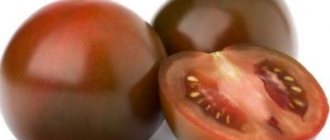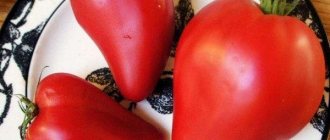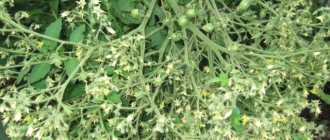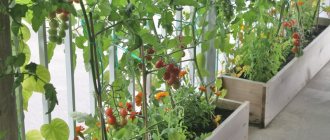Tomato Tourmaline is a variety of tasty and easy-to-care tomatoes that are easy to grow in the garden. The fruits are pink, the variety is considered one of the sweetest tomatoes. According to gardeners, it is better to grow in open ground.
| Height | Landing location | Ripening time | Fruit color | Fruit size | Origin | Fruit shape |
| Medium height | Greenhouse, Open ground | Mid-early | Pink | Average | Variety | Flat-round |
Tomato Tourmaline - description and characteristics of the variety
Ass are not only a universal vegetable crop, but also a product useful for the body. The Tourmaline tomato variety has a pronounced sweet taste and contains many useful microelements.
The selenium present in the composition prevents premature aging. Civilization grows and bears fruit excellently in greenhouse conditions and in open ground.
The class is characterized by high productivity with minimal care.
Low-growing shrubs reach a height of 70 cm. The fruits become round. The skin of tomatoes is smooth and durable, not prone to cracking. The weight of one fruit is about 170 grams. Larger specimens can reach a weight of 220 grams. As tomatoes ripen, they acquire a pink or crimson color.
The pulp is dense and fleshy; when grown in cool summers, tomatoes acquire sourness. Tomatoes grow in clusters, with 6-8 fruits in each cluster. From one bush you can collect up to 5 kg of ripe tomatoes. The first inflorescence is tied after the 6th leaf and is repeated every 2.
Application of fruits
The variety was bred mainly for fresh consumption and salad preparation. Fragrant fruits with thin skin will decorate any festive triclinium. In addition, vegetables are often used for canning. Durable leather does not crack during heat treatment during pickling. This variety of tomatoes makes wonderful sauces and juice.
Features of cultivation
It is necessary to raise seedlings at a temperature of 22-25 degrees. At low temperatures, proliferation is very slow. Sowing is carried out in mid-March. To avoid various diseases, it is not recommended to grow ass after potatoes or other tomatoes.
An excellent area would be where zucchini, cabbage or parsley grew. Seedlings are scattered into loose, fertile soil. To do this, it’s a good idea to mix the soil with peat and sand. The seeds must be treated in a weak solution of potassium permanganate.
After this sowing, the boxes are covered with glass or cling film and put away in a warm and sunny place.
For a permanent location, seedlings are planted in late May or early June. Low-growing bushes require staking. The bushes do not need to be pinched; this has a very real effect on saving time in care.
Planting is done while maintaining a standing position (on a stone thrown between the bushes, it should be 30 cm.
Rules before leaving
It is better to prepare the soil for planting tomatoes in the fall. It is advisable to add organic fertilizers and wood ash to it. Limestone or dolomite flour is added to the acidic soil. About 3 times a season, tomatoes should pick up complex additives. Bushes should be watered sparingly. When overwatered, plant roots may rot.
Tomatoes are quite resistant to various diseases and pests, but for prevention they should be treated with special preparations.
It is definitely recommended to loosen the soil and remove weeds. This method can be used to get rid of insect larvae that have settled on the root system.
The soil should be loosened carefully so as not to damage the roots. Experts recommend conducting a visual inspection of the bushes from time to time for the presence of pest invasions and the development of diseases.
When problems are detected, it is necessary to remove the affected leaves and spray the plants with insecticides.
If you (soon) follow all the rules of agricultural technology for growing the variety, as well as adhere to proper care, you will be able to get a good harvest and healthy, high-quality fruits. Gardeners speak positively about the characteristics of the Sherl variety.
Features of cultivation
It is necessary to raise seedlings at a temperature of 22-25 degrees. At low temperatures, proliferation is very slow. Sowing is carried out in mid-March. To avoid various diseases, it is not recommended to grow ass after potatoes or other tomatoes. An excellent area would be where zucchini, cabbage or parsley grew. Seedlings are scattered into loose, fertile soil. To do this, it’s a good idea to mix the soil with peat and sand. The seeds must be treated in a weak solution of potassium permanganate. After this sowing, the boxes are covered with glass or cling film and put away in a warm and sunny place.
As soon as 2 leaves are formed on the seedlings, they are picked. The seedlings should be hardened off 2 weeks before planting. Each time the pots with seedlings are taken outside, gradually increasing the stay time. For a permanent location, seedlings are planted in late May or early June. Low-growing bushes require staking. The bushes do not need to be pinched; this has a very real effect on saving time in care. Planting is done while maintaining a standing position (on a stone thrown between the bushes, it should be 30 cm.
Description of the Big Beef variety
Big Beef is a mid-season tomato variety. Big Beef tomatoes can weigh up to 800 grams. If you regularly carry out pinching and remove excess ovaries, you can get fruits weighing about 1-1.5 kg. The following will help you appreciate the Big Beef f1 tomato variety: description, characteristics of the fruit, reviews from farmers.
Description of the Big Beef F1 tomato variety:
- Bushes with intensive growth, grow up to 2m.
- Ripening time is 73 days after planting in open ground.
- Productivity – 9 kg of tomatoes per 1 sq.m of soil. 5-6 fruits are formed on one brush.
The main advantage of the Big Beef tomato is resistance to diseases. In mid-summer, you can fully harvest beautiful and healthy fruits. The variety is grown in the southern and northern regions. It is relatively resistant to low temperatures. The yield of the variety remains consistently high.
Characteristics of Big Beef fruits
This variety can be grown on an industrial scale
Beef in English means "meat". The main feature of the Big Beef tomato is its meatiness. The volume of pulp significantly exceeds the volume of seeds.
- Ripe fruits are red.
- The shape is flat-round, slightly ribbed.
- The average weight of one tomato is 350-450 g.
- The pulp is juicy and moderately dense.
- Inside the pulp there are 6 seed chambers.
- The skin is dense and does not crack.
- The taste is sweet and sour, pleasant.
Big Beef tomatoes have excellent commercial qualities and can be grown on an industrial scale. The fruits retain their appearance and taste during transportation. The fruits can be eaten fresh or in salads. They make excellent-tasting juices, sauces, and pastes. It is difficult to preserve large fruits. In the jar they wrinkle and crack.
Description of the Siberian giant tomato and agricultural technology for cultivating the plant
The Siberian giant is a tomato characterized by high productivity, large fruits, and is popular among gardeners. The variety is recommended for cultivation in greenhouses. Tomato resistance to temperature changes allows the plant to be cultivated in open ground.
Advantages of the variety
Characteristics and description of the Siberian Giant tomato variety are associated with high productivity and average ripening time. Fruiting occurs 115-120 days after emergence.
During the growing season, bushes with a height of 1.5–1.7 m are formed. When grown indoors, the height of the plant reaches 2–2.2 m.
When a bush is formed into 1-2 stems, large fruits reach a weight of 300-500 g, and individual giant tomatoes weigh up to 1.2 kg. The yield per 1 m² is 4-7 kg.
Description of fruits:
- The tomatoes are round, flat in shape, ribbed on the sides, intense red in color (the Siberian Giant variety has fruits of intense pink color), without a green spot on the stalk.
- When cut horizontally, seed chambers with a small number of seeds are observed.
- Fleshy and sweet-tasting fruits are used fresh and for processing into purees and pastes.
Tall bushes require additional support and tying. The variety is valued for its disease resistance, large fruits and excellent taste.
Agricultural cultivation technology
The Siberian giant tomato is recommended to be grown in seedlings. Before planting seeds for seedlings, they are treated with an aqueous solution of potassium permanganate and a growth stimulator. Sowing is carried out 60-65 days before the intended planting in the ground. They are placed in containers with prepared soil to a depth of 1.5 cm.
The soil is moistened using a sprayer with warm water. The containers are covered with film until the sprouts hatch. In the phase of formation of 2 true leaves, seedlings are planted in separate pots. To avoid damaging the root system during replanting, it is recommended to use peat containers.
When planting in a permanent place, you need to maintain a distance between the bushes so that their roots and stems do not interfere with growth. Tomatoes love fertile soil, so when planting them in the holes, add organic fertilizers and periodically feed the crop with complex preparations.
Among fertilizers, preference is given to manure, peat, chicken droppings and mineral fertilizers containing phosphorus and potassium.
When transplanting bushes to a permanent place, the holes are laid at a distance of 40-60 cm. The bushes must be tied to a support, and the stepsons and lower leaves are removed. At the end of the growing season, the growing point of the crop is pinched.
The variety, developed in Siberia specifically for cultivation in cool regions, is recommended for cultivation mainly in greenhouses.
Siberian giant tomatoes can be planted in open ground; they adapt well to sudden temperature changes and are resistant to many diseases. But to protect from rain, wind, and dew, it is better to cover the bushes with a special film.
Opinions and recommendations of gardeners
The yield of a crop depends on compliance with the rules of agricultural technology, which provide for timely watering, fertilizing, temperature and light conditions. Timely loosening of the soil and hilling of bushes help strengthen the crop and increase the yield of fruits from the bush.
Plants are watered with warm water, and fertilizing is recommended at different stages of the growing season. Periodic preventive maintenance of biological pests contributes to the normal development of the crop.
Reviews from vegetable growers who grow this variety indicate the benefits of tomato, taste, resistance to weather conditions and diseases.
Marina Yakovleva, 53 years old, Novokuznetsk:
“I planted the Siberian giant tomato in a greenhouse. I chose these tomatoes because of their large fruits, taste and resistance to temperature changes.
Due to its large size (the smallest tomato weighed 360 g), we had to preserve it in slices.”
Evgeny Gorshkov, 61 years old, Domodedovo:
“I have been growing the Siberian giant variety for several seasons
I paid attention to the large size of the vegetables and the crop’s resistance to cold. The main thing for a plant is the presence of fertile soil, timely watering and weed control.
The bushes are not fussy to care for, but they require removing the shoots and tying them to a support. The taste of juicy tomatoes is sweet, they are pleasant to pick from the bush.”
Nuances of cultivation
The Beef variety is grown in open ground or in a greenhouse - the main role is played by the season and region where the tomato is planted.
The agricultural technology of this type of nightshade is simple:
- If there are a large number of ovaries on the hands, it is necessary to pin the bush. The procedure is necessary so that the plant does not waste energy on the growth of additional stems and foliage.
- Gardeners recommend forming a bush with 1 stem. This will increase its productivity.
- Caring for the plant requires regular watering, weeding the beds and periodic feeding with minerals. Fertilizers are applied several times per season. The first feeding is carried out 7 days after planting the seedlings, the second - before the appearance of small tomatoes.
- After transplanting the seedlings to the beds, the holes must be mulched. For this, sawdust or straw is used.
Further care will not cause much trouble. It is recommended to water the bushes with settled water at least 2 times a week. They fertilize the plants with complex minerals and periodically prevent the appearance of fungi and pests.
Tomato seedlings are harvested in early spring. It is planted in open beds 65-70 days after sowing the seeds. By this time, the root system has already formed and is ready for full growth.
Place 3-4 seedlings per 1 m². More bushes are not required, since adult tomatoes will interfere with each other in the future and the root system will suffer from this.
Planting seeds directly into open ground is rarely practiced. At the same time, some gardeners plant planting material under film.
B
- Ballad
- Ballerina
- Banana orange
- Bagheera
- Barmaley
- Babushkino
- Grandma's basket
- Grandma's pride
- Darling of fate
- Banana legs
- Banana red
- Butterfly
- Barberry
- Baron
- Dad
- Master
- The Velvet season
- Grandma's gift
- Barnaul Cannery
- Grandma's kiss
- Grandma's secret
- Belfort
- Belle
- Betta
- Bella Rosa
- Dimensionless
- Berkeley tie-dye
- Berberana
- Betalux
- Snow White
- Benito
- White sugar
- White filling
- Seedless
- Kasadi's Madness
- Bison yellow
- Business lady
- Biysk rose
- Beef pink brandy
- Steak
- Biathlon
- Beef Beef
- Bison orange
- Bison black
- Black cherry
- Blue r20
- Blagovest
- Big Dipper
- Big striped boar
- Bolivar
- Barrel
- Bonsai
- Fighter
- Bobcat
- Bon appetit
- Bonanza
- Bochata
- Boyarina
- Swamp
- Boni MM
- big rainbow
- Big Mama
- Ladybug
- The house is rich
- Bonaparte
- Bokele
- Brother 2
- Brandy pink
- Briscolino
- Brandywine black
- Berdsky large
- Brave General
- Boogie Boogie
- Bourgeois
- Bouquet of Siberia
- Bugai pink
- Burkovsky early
- Budenovka
- Bulat
- Pinocchio
- Bystrenok
- Bulls-eye
- Bull's heart
- Bull forehead
Description of the variety
"Andromeda" bushes belong to the determinant type with limited growth. In open ground they do not grow higher than 60-70 cm; in a greenhouse the stem can stretch up to 1 m. The foliage is average, the color of the leaves is light green.
IMPORTANT: A characteristic feature of this hybrid, which has a direct impact on agricultural technology, is its underdeveloped root system.
The variety has three varieties, differing in color, size and some other features:
- Pink is the earliest ripening of the three and has dark green leaves with an anthocyanin tint;
- Golden – characterized by large fruits;
- Red has balanced characteristics and is therefore the most popular.
“Andromeda” belongs to the mid-early tomatoes. Depending on the subspecies, the ripening period of the variety is:
- 80-90 days – for the pink subspecies;
- 104-112 days – for gold;
- 90-115 days – for red.
The weather can have a significant impact on the timing of ripening. Prolonged rains and cold snaps can extend the growing season by 1-2 weeks.
Tomato Andromeda F1:
Fruit
Andromeda tomatoes have a classic appearance: flat-round shape with mild ribbing, compact size, smooth skin, dense pulp. The average weight of one copy ranges from 70-125 grams. Pink tomatoes are slightly larger than red ones, they can weigh up to 135 grams. But the largest-fruited subspecies is “Andromeda Golden,” whose tomatoes reach 320 grams.
Disease and pest control
Honey drop is little susceptible to major tomato diseases. Of course, if the plants in the garden are infected with late blight, then this tomato will also suffer. But he rarely gets sick first. Things are worse in the greenhouse, where the variety gets sick more often. Main reasons:
- thickening of bushes and plantings;
- high humidity.
To prevent diseases, the room needs daily ventilation.
Honey drop grows well both in a greenhouse and in open ground
If you plant tomatoes in the same place every year, pathogens—disease agents—accumulate in the soil. To improve the microflora in the soil at the roots of the tomato, it would be good to mulch the plantation with dried hay.
When planting a variety to prevent diseases, it is enough to treat it with a solution of Fitosporin-M once every 10 days. In case of emerging diseases, use copper-based fungicides.
Of the pests, the cutworm and tomato leaf miner are the most annoying to tomatoes. The caterpillars of these butterflies eat holes in the fruits. If the invasion is not stopped, the harvest will suffer. The best means of control is considered to be spraying with the biological product Bitoxibacillin.
The bollworm moth often lays eggs on weeds, so you need to weed your garden regularly
Folk remedies for armyworms and moths only work as a preventive measure. To prevent butterflies from entering the garden, the plants are treated with a decoction of garlic.
Preparing a remedy for caterpillars:
- Boil 300 g of garlic in 3 liters of water for an hour.
- Filter, bring the volume to 10 l.
This product also repels other tomato pests.
I grew Honey Drop for two years in a row, but gave it up. A friend, presenting seeds of this variety, called it pampering and added: plant no more than two bushes. Now I understand why. The fruits turned out to be too small for such a huge bush, although I planted it. But the green mass also removes a large amount of nutrients from the soil. It takes a long time to make a salad from small things, because I cut out the places where the stalks are attached. The tomato is not suitable for juice: the small seeds quickly clog the strainer of my juicer. If you add it to preserves, you need a little fruit for beauty, because their pulp is too watery. True, one day I was treated to wonderful juice from these tomatoes. I was struck by the unusual taste, as if it was squeezed out of exotic fruits. I replaced this tomato with another snack variety - Black Cream. Its fruits are slightly larger, the taste is richer and the yield is higher for the same bush size.
Characteristics of pink-fruited Tourmaline tomatoes and general description of the variety
The Tourmaline tomato is a pink-fruited variety. These tomatoes are distinguished not only by their beautiful coloring, but also by their excellent taste.
General description of the variety
The Tourmaline tomato variety is of a determinate type, forms low bushes (70-100 cm), and after setting fruit, 5-6 clusters grow independently. With a mid-early ripening period, you can have time to get an additional harvest on the side shoots. According to the nature of fruiting, it is suitable for cultivation in greenhouses and greenhouses, but is mainly intended for cultivation in open ground.
The plant is powerful, has a tendency to increase the formation of lateral shoots
Taking into account the feedback from vegetable growers, it is recommended to form the bush and grow it into 2-3 stems in order to slightly extend the harvest period. When formed into 1 trunk, it bears fruit in early July and quickly ends the growing season (in 3-4 weeks)
Requires a mandatory garter.
Productivity is high. From each bush it is possible to collect up to 5 kg of marketable products. The Tourmaline variety is not susceptible to late blight and retains a high ability to bear fruit even in cold and rainy summers.
Features of the fruits of the Tourmaline variety
The shape of tomatoes is round, flattened at the poles. A slight ribbing is noticeable near the stalk, but below the shoulders of the fruit the surface becomes even and smooth. Ripe tomatoes have a beautiful gloss and bright raspberry-pink color. Unripe Tourmaline has a dark green spot at the base of the fruit, but this disappears as it ripens.
The clusters contain 5-8 tomatoes of approximately the same size. Ovaries are formed from all flowers, the racemes are well filled. In too hot weather (above +35 °C), some flowers may remain unpollinated due to pollen sterilization. In greenhouse conditions, this characteristic of tomatoes can reduce the yield of the variety.
The skin is distinguished by the tenderness characteristic of all pink varieties. But Tourmaline tomatoes are practically not susceptible to cracking, which spoils part of the first harvest.
The tomato pulp is dense, but not hard. It has a fleshy consistency, juiciness and a pleasant sweet taste. In cold summers, Tourmaline tomatoes may acquire slight sourness.
The main purpose of the variety is salad. Tasty and aromatic fruits are suitable for preparing summer salads and gourmet snacks; slices can be used for sandwiches and beautiful holiday cuts. The successful combination of taste and color makes it possible to use pink tomatoes for sauces for Italian dishes.
It is convenient to preserve small fruits in their entire form. They do not lose density and do not burst when exposed to heat, but for the best result you should choose well-colored, but not yet completely ripe tomatoes.
Tomatoes that are overripe and have lost their elasticity are better suited for making tomato juice or puree for lecho. The pulp of such fruits releases more juice, leaving very little waste. When heated, the rather light tomato pulp acquires a rich hue, so in the end the products will turn out quite bright.
Agricultural technology of the Tourmaline variety
It is better to prepare the soil in the fall by introducing rotted organic matter and wood ash into the soil (0.5 buckets per 1 m²). Dense, acidic soils need to be limed by adding chalk, dolomite flour and others at the rate of 0.5-1 kg per 1 m².
The quality of the future harvest depends on how well the seedlings learn. To prevent plants from stretching out, they should not be sown too early. The best time is 50-60 days before landing at a permanent place. The seeds germinate quickly at a temperature of +25 °C and high humidity, so after sowing the container is covered with glass and placed in a warm place.
When shoots appear, the glass should be removed and the box should be moved to cooler conditions. The average temperature at which Tourmaline tomatoes grow is +20 °C, but the root system of the plants cannot be cooled. Even at night, the ground temperature should not fall below +16 °C.
At the age of 1-3 true leaves, tomatoes are picked into separate pots or a box according to a 10x10 cm pattern. To obtain strong seedlings, three-time picking is used, replanting the tomatoes as the leaves close if they grow in a common box. The pots can simply be moved away from each other.
Before planting in the beds, tomatoes are hardened by taking them out into the fresh air for 1-2 weeks for an increasingly longer period. You can plant it in the garden after the end of the return frosts. The planting pattern is 30x30 cm; a passage of at least 70 cm wide is left between double rows.
The best varieties of tomatoes for 2021: photos and descriptions
When choosing tomatoes for their plot, gardeners, first of all, rely on varietal or hybrid characteristics. Productivity is the most important criterion on which the quantity and quality of the harvest depends. Sometimes it can be difficult to choose the right option from the rich variety of tomatoes for open ground and greenhouses. Then varieties are selected depending on the growing region, ripening period, degree of disease resistance and other factors.
A huge number of species with excellent yields are intended for growing vegetables in the open air. Low-growing bushes with large fruits are one of the advantages of tomatoes for the soil. Such heat-loving plants are easier to care for and do not require complex agricultural practices.
According to ripening period
Tomatoes, like other vegetable crops, are characterized by different ripening periods, from early to late.
| Ripening period | Ripening of fruits after the appearance of the first shoots | general characteristics | The most productive tomatoes (2020) |
| Ultra-early ripening | On day 80-85 | The fruits are small, juicy, and low in sugar. The height of the bush is no more than 50 cm. Not suitable for preservation. | Little Red Riding Hood, Pride of Russia, Benito, Superstar, Valentina, Marisha, Maksimka |
| Early ripening | For 90-95 days | Small, delicate fruits, average yield. Suitable for canning and salads. Bushes grow up to 70 cm | Agatha, Riddle, Augustine, Lyana, Sanka, Buyan, Lakomka, Amur standard, Grandmother's kiss |
| Mid-early | On days 100-103 | The fruits are juicy, small, aromatic. The purpose is universal. Bush shape - compact | Openwork, Babushkino, Pulka, Red Giant, Russian Soul, Cardinal, Flamingo |
| Mid-season | On day 100-115 | High taste, excellent yield. There are both low-growing and tall varieties | Scarlet Candles, Hybrid Basket, Stresa, Intuition, Black Baron, Pudovik, Pink Honey |
| Late ripening | On day 120-130 | Excellent fruit taste, high yield, universal purpose. Good keeping quality and transportability of fruits | Giraffe, Cosmonaut Volkov, Titan, Rio Grande, Russian size, King of Kings, Rocket, Premier |
The ripening time, color and shape of tomatoes depends on the variety.
Usually early-ripening vegetables with not large fruits and not a large harvest, but with a quick, friendly yield of ripe tomatoes. Mid-season ones also have medium sizes. Late ones are usually difficult to care for, but it is among them that you can find champions in weight, but there are not many such beauties on the bush.
Every year, breeders create new species with high quality indicators. In stores you can buy specialized varieties of tomatoes designed for growing in certain climatic conditions. Classification by regions of Russia:
- for the Moscow region: Champion, Sweet Bunch, Honey, Pink Elephant, Fireworks, Bull's forehead;
- for the southern regions: Torch, Novice, Titan, Winner, Bison, Ermak, Gift, Mikado;
- for the middle zone: Bull's Heart, Black Prince, Uzbek (Yusupov), Moskvichka, Snowdrop, Big Brother, Spasskaya Tower;
- for Siberia: Siberian heavyweight, Ultra early ripening, Sanka, Abakan pink;
- for the Urals: Coin, Bull's Heart, Button, Countryman, Yellow Buyan, Bullfinch, Demidov;
- for the far north: Snowy Tale, Ballerina, Ladyfingers, Berdsky Large, Countryman, Oak, Gina.
An unpredictable, cold or, conversely, excessively warm climate is not a reason to refuse to grow tomatoes in open ground. Thanks to selection, varieties have been developed that grow and develop well in any terrain.
To obtain a rich harvest, you need to choose tomato varieties not only with the appropriate characteristics. It is necessary that this criterion be supplemented by such an indicator as disease resistance.
Late blight, root rot, tobacco mosaic, cladosporiosis are diseases that most often affect plantings of heat-loving crops.
A catalog of tomatoes that can withstand the onslaught of various diseases:
- Blitz;
- Koenigsberg;
- Geisha;
- Betta,
- Anyuta;
- Bohemia;
- Chio-chio-san;
- Tatiana;
- Puzata hut;
- Lights of Moscow;
- Yablonka Russia;
- Crimson giant.
Unfortunately, there are no varieties that are 100% resistant to infections. But there are hybrids that produce a harvest until the active phase of many fungal diseases and infections begins.
Having a good greenhouse at your disposal, you can get fresh tomatoes to your table all year round. Greenhouse varieties are suitable for preparing salads or canning. Excellent salad tomatoes can be obtained from the following varieties:
- Geisha;
- Fairy gift;
- Andromeda;
- Eagle beak;
- Pink Angel;
- Pink Pearl;
- Fatalist;
- Scarlet caravel;
- Amana orange
The best varieties for preservation:
- Auria;
- Banana legs;
- Pink raisins;
- Rajah;
- Baba;
- Alexander the Great.
Cherries are sweet, small tomatoes that grow well both outdoors and in a greenhouse, but small-fruited vegetables tend to be more productive in protected beds. Magic Harp F1 and Yellow Caramel F1 are hybrids whose fruit weight does not exceed 25 g.
When choosing a vegetable for a greenhouse, many rightly give preference to tall and high-yielding varieties. But low-growing plants, which usually have an early ripening period, as well as mid-ripening tomatoes, are also excellent for polycarbonate shelters in all regions of Russia.
For open ground, breeders also offer species with high yields of hybrid origin; they are resistant to diseases and temperature changes. The best tomato varieties of 2020:
- Intuition F1 is one of the best tomato hybrids for picking with trusses, mid-season, from germination to harvesting the first vegetables - 110 days.
- Katya F1 is an early ripening hybrid. The fruits weigh 90-130 g and ripen simultaneously. From 1 m² you can harvest more than 10 kg of fruit per season.
- Search F1 – unpretentious and at the same time tasty tomatoes. The hybrid withstands cold weather and is immune to most diseases. The bushes are strewn with small red fruits, which are excellent for pickling and canning.
- Blagovest F1 is an early-ripening hybrid. The fruits are round, glossy, with slightly pronounced ribbing. From one bush you can collect up to 5 kg of fruit.
- La la fa F1 - has excellent consumer qualities, high yield and unpretentiousness. The average weight of the fruit is 140-170 g. From 1 m² you can harvest up to 20 kg.
- Vladimir F1 - has a high yield and is suitable for cultivation in any type of soil. High productivity throughout the entire fruiting period.
- Beef King F1 is an early maturing Dutch hybrid. The tomatoes are round, dense, smooth. From one bush you can collect up to 4-5 kg. Resistant to low temperatures and diseases.
- Ashdod F1 – tomatoes with smooth, dense skin. Fruit weight is from 110 to 140 g. The pulp has a bright burgundy color.
- Tanya F1 is a hybrid from the Netherlands with excellent immunity, dense structure, and good yield. The fruits have a regular round shape, weighing 150-200 g. They tolerate transportation well.
READ MORE: Japanese quince chaenomeles photo planting and care
If on a bag of planting material the designation F1 is a hybrid of tomatoes (or other plants) of the first generation, F2 is a hybrid of the second, and so on.
Exceptional taste, fruit weight, constant yield, disease resistance, adaptation to weather conditions are the advantages of hybrids over tomato varieties.
Reviews
My favorite tomato variety in 2021 is Idol, medium-sized, very tasty, productive. I planted seedlings on March 20, the first fruit was picked on June 20. The bushes bear fruit for 3 months. The most successful cherry variety is Black Cherry, very tasty and productive, the most favorite tomato of children.
I like the fruits to be large and regular in shape. Therefore, I prefer the varieties Early Rose, Peach, Heavyweight of Siberia and Pink Fig. This year I raised Grandma's Secret. The bush is determinate, the average height is 180 cm. I have never produced kilogram fruits, the maximum weight is 700-800 g. Probably this is because I allow the bush to form into two or three stems.
I never conduct systematic analysis. I analyze when the tomatoes are already picked. I love large, sugary berries. I really like the Pink Giant in taste, but the yield is low. So far, my requirements are relatively met by 2 varieties - Pink Andromeda and Mazarin. Over time (I’m a novice gardener) I’m thinking of finding the optimal variety or hybrid of tomatoes.
Now I mainly grow tomatoes in my dacha. About 20 different varieties. Red, yellow, brown, black. Beauty! Cherry, Cream, Ox heart. Different sizes, different tastes, different ripening periods - from May to October. The main thing is that the weather is warm. I’m not keen on canning, so we use fresh vegetables. If the harvest is good, I give the remaining tomatoes to relatives.
Stability of the harvest from year to year, the ability to adapt to weather conditions, resistance to pests and diseases are important criteria for a reliable tomato variety. In 2021, you can plant both time-tested tomatoes and new elite varieties. The choice depends only on the preferences of gardeners.
Advantages and disadvantages
Big Beef tomatoes f1 have positive qualities:
- Resistance to fungi and pests.
- Easy to care for.
- Excellent keeping quality.
- Excellent taste.
Among the shortcomings, we can only mention the painstakingness of pinching and forming a bush. But if you know in advance how the manipulation is performed correctly, then the work will not cause any difficulties.
At the stage of bush growth, they need to provide additional support and tie branches with ovaries to the trellis. The Biff tomato variety group has very large fruits, so they cannot do without a garter.
Many farmers choose the Beef variety for cultivation for trade. The fruits are widely used in the industrial production of tomato products.
A tasty and juicy tomato is perfect for home use. It can be added to first and second courses, canned and fried.
The high yield of this type of tomato attracts an increasing number of gardeners. This variety is unpretentious and tolerates slightly acidic or alkaline soil. Gardeners still recommend neutralizing the acidity level of the soil using special means, since the taste of the fruit simply depends on the nutrients contained in the soil.
Growing tomatoes
"Andromeda" is a universal variety. It grows well both in greenhouses and in open ground. The traditional growing method is seedlings.
How to prepare seeds?
Seeds of “F1” hybrids usually go on sale already treated and disinfected from microbes. The passage of such treatment may be indicated by the inscription on the label: “Do not treat the seeds.”
The following activities are recommended as additional pre-sowing preparation:
- Stimulation with Epin-Extra or Sodium Humate. Stimulants not only increase seedling germination up to 90%, but also improve plant immunity;
- Soaking in melt water for 12 hours before sowing. The procedure accelerates the emergence of seedlings.
Sowing seed material
Sowing is carried out in the first ten days of March - 2 months before planting in a permanent place. The soil for seedlings should be loose and nutritious. The best option is a mixture of peat, turf and sand in equal proportions. The choice of container is not important. The main thing is that it contains a sufficient number of drainage holes and is at least 5 cm deep. Most often they are planted in wooden boxes or “chests” made of tetrapacks.
Seeds are planted to a depth of 2 cm and watered abundantly. In the first days before the emergence of shoots, the greenhouse regime is maintained with the help of film up to 30*C, then the film can be removed and cultivation can continue at a temperature of 22-24*C.
IMPORTANT: At the phase of the appearance of the second true leaf, picking is carried out. It is best to immediately plant the plants in separate peat pots - this will protect them from stress during subsequent replanting.
Rules for planting seedlings
Planting in open ground is done in May, when the ground warms up to 12*C and the air temperature does not drop below 17*C. Plants are replanted with a large ball of earth so as not to damage the roots. A handful of peat and a handful of humus are added to the planting holes.
Recommended planting pattern:
- The disembarkation order is staggered;
- The interval between bushes is 50 cm;
- Row spacing – 60 cm;
- Planting density – 4 bushes per 1 sq.m.
Planting and care
Openwork F1 is cultivated only in seedling form. Seeds are sown at home in March-April. At the end of May and beginning of June, the seedlings are transplanted into open ground. Harvesting begins at the end of July and continues throughout August.
To speed up the germination of seeds, immediately before sowing, they are soaked for 12 hours in a 0.04% solution of sodium humate, and then germinated on a saucer, the bottom of which is covered with cotton cloth. In this case, the seeds must be kept in the dark and always moistened, for which the saucer is covered with an opaque moisture-proof lid.
The germinated material is placed in a place where the temperature is kept in the range of 20-25 degrees. Every day the seeds are opened and their moisture level is checked. As soon as the first seeds begin to germinate, the entire batch is sown in a very loose peat mixture filled with superphosphate - a pinch of phosphorus fertilizer granules per liter of substrate.
As soon as cotyledon leaves appear en masse on the soil surface, the box is transferred to the cold and kept at a temperature of 15-16 degrees so that the seedlings do not stretch out and grow a good volume of roots. After 2 weeks, the seedlings are picked and transferred again to warmth, where they are grown until they reach the age of 55-60 days. At the time of planting, good tomato seedlings should have 7-8 true leaves and a height of about 30 cm.
The planting pattern for the garden bed is single-row, 40 cm in a row, 60 cm between rows. There should be 3-4 plants per square meter.
Before planting (a day before), carry out abundant moisture-recharging watering of the beds. Immediately after planting, the seedlings are watered again with heated water, spending at least 1 liter per hole.
Hybrid Azhur stops its growth itself, so it has a naturally compact bush. The central stem stops lengthening after the formation of 4-6 clusters. Then growth continues on the stepchildren. The first cluster of inflorescences appears above the sixth or seventh leaf, the next ones follow each other.
Plants lead in 1-2 branches. All stepsons growing from the axils of the leaves are removed, leaving for the second stem the shoot that appeared under the first flower raceme. The first circumcision of the stepchildren is carried out simultaneously with the garter.
By the time the tomatoes ripen on the first tassel, they begin to cut off one bottom leaf weekly. This technique will slow down the development of fungal spores and ensure the flow of nutrition to the growing fruits.
Landing
Seeds are sown for seedlings for growing in open ground in the second half of March or early April. When using a greenhouse or film cover - in early March.
Before sowing, the seeds are checked by immersing them in a glass of salted water. Those that float are thrown away: these are usually empty ones that will not rise. The rest are rinsed and disinfected in aloe juice, Fitosporin solution or potassium permanganate. Rinse again and treat with Zircon, Epin or another stimulant.
The soil is purchased in the store (a mixture “For tomatoes and peppers”) or prepared from equal parts of turf soil, peat and humus. Add 0.5 parts of sand or sawdust, 2-3 handfuls of wood ash per 10 kg of substrate and 2 tsp. mineral fertilizer. The mixture is calcined in an oven or poured with a hot fungicide solution. After 2–3 days, tomatoes are planted.
The seeds are sprinkled with a layer of no more than 1–2 cm, carefully watered and placed next to the heating radiator, covered with film. With the appearance of sprouts, it is recommended to reduce the temperature to +16 for 3 days to strengthen the root system, then the indicator is set to +18–22 degrees.
If necessary, feed the seedlings with a weak solution of nitrophoska or urea. They dive after two leaves appear.
On a bed of 1 sq. m place 3–4 bushes. Choose sunny areas without drafts. Predecessor cultures:
Mineral fertilizers are first applied to the holes, but they are placed a little to the side so that the roots do not touch. The walls are sprinkled with wood ash or humus is added. The holes are spilled with water until the liquid stops being absorbed, the seedling with a lump of earth is carefully transferred, and not watered for 10 days.
Features of the Big Beef f1 tomato variety and growing tips
Western breeders have developed a wonderful hybrid of the nightshade crop - the Big Beef tomato. In the West, such tomatoes are called beefsteak, but in our country the term meaty has taken root. It lends itself well to heat treatment and retains its density. In addition, the tomato grows quite large in size, as can be seen in this photo:
The largest fruit that was recorded reached a weight of about 2 kg. The Big Beef variety has taken root well in our regions. It is most productively grown in the southern regions.
Reviews about the Big Beef f1 tomato are only positive. Gardeners characterize the tomato as a hardy, unpretentious and high-yielding plant. This hybrid does not cause any trouble in growing.
Ask and receive useful advice from professional gardeners and experienced summer residents.>>
Description of tomato Goldfish
An indeterminate shrub without limiting the end point of growth belongs to the mid-late varieties. From the moment young tomato shoots sprout until the first harvest, 3.5 months pass, in open ground 10–14 days later. “Goldfish” tomatoes can be grown in greenhouse structures in the Urals, Far East, and Siberia. In areas with warm climates, tomatoes have time to ripen without additional shelter.
External description of the tomato variety “Goldfish”:
- The main stem is not stable, it is not thick and powerful enough to withstand the weight of ripe tomatoes without additional support.
- It reaches a height of two meters; in a greenhouse, the top of the tomato is broken at a level of 1.5–1.7 m; the maximum height of the variety in open ground is 110–120 cm.
- In a greenhouse, a tomato is formed with one, often two, trunks in an unprotected area, using 3–4 stems.
- The variety has high foliage, the leaves are narrow, elongated, dark green, with a large number of small carved fragments at the end. The resemblance of the leaves to the caudal fin of a fish and the beautiful color of the fruit gave the corresponding name to the tomato.
- The flowers of the “Goldfish” tomato are yellow, collected in simple inflorescences, and in 90% of cases they produce ovaries. The clusters are long, the first growth begins at the height of the eighth leaf, the subsequent ones are laid after 3. The average fruiting capacity is 5–7 fruits.
Description of fruits
Goldfish tomatoes can be classified as exotic species due to their unusual color, which is unusual for traditional representatives of the nightshade culture:
- the first ripe tomatoes are a rich, bright yellow color with a slight orange tint, becoming a shade lighter towards the end of the growing season;
- the weight of the fruits of this variety varies from 220 g on the lower circle to 130 g on subsequent clusters;
- the shape of an elongated oval (plum-shaped) at the end with a pronounced process, the so-called spout;
- pulp of dense consistency, juicy, sweet with no acid;
- the seeds of the variety are large, beige in color, located in 4 chambers;
- the peel is thin, glossy, durable, and not prone to cracking.
The tomato owes its color to the high concentration of carotene in its biological composition.
Tomato Amber
When choosing a new variety of tomatoes, it is worth collecting as much information as possible
It is important to know whether the climate and soil are suitable for the variety, and whether it will have time to form fruits, taking into account the length of the seasons. For example, the Yantarny tomato is an excellent choice for growing in Siberia and the Urals
Characteristics and description of the tomato variety Yantarny
The variety was bred by Siberian breeders. Ultra early ripening, determinate, standard. Suitable for growing in greenhouses, indoors or open ground.
Amber tomatoes are great for pickling, fresh salads, stuffing, freezing or drying, as well as for tomato juice. Well preserved and transported.
Description of the tomato variety Yantarny
The variety is characterized by the following features:
- Cold resistant. Withstands light frosts (up to -1), although some leaves may freeze. Fruits set, even if flowering occurs during cold weather.
- The productivity of the variety is high. From one sq. meter you can get about 5 kg.
- The fruits ripen within 80-100 days, so the variety is ultra-early ripening.
- Abundant flowering. Brushes are formed above the 5-6th leaf, and then through the leaf or two in a row. The flowers are self-pollinating and cold-resistant.
- Determinate, standard bush, stops growing on its own, without pruning the top.
- The branching is active and abundant, forms a wide, low bush up to 60 cm in height.
- The stalk is juicy and thick. The leaves are medium sized, bright green.
- The tomato is yellow, often amber in color, with thin skin. Diameter - 5-6 cm, spherical shape, weight about 70 g. The fruit is juicy and sweet.
- The variety is resistant to macrosporiosis and late blight, and also easily tolerates adverse weather conditions.
Note! There is a variety with a similar name - Yantar tomato, the characteristics and description of the variety are different from Yantarny, do not confuse them
Growing technology
There are no specific features in planting and caring for this variety. Basic Rules:
- It is advisable to plant the variety as seedlings, but planting in open ground is also possible. In the first case, you need to sow in March - early April, in the second - at the end of May. The seeds are buried 1 cm, watered abundantly, and covered with glass or film.
- Picking - you can do without this procedure, but still, after two true leaves appear, it is recommended to plant the bushes one or two in separate pots.
- Planting in open ground in May-June. You first need to harden the seedlings by taking them out into the fresh air every day for a week. The planting pattern should be 60 by 70 cm, and the soil should be light, slightly acidic, and moist.
- Standard varieties do not shoot and usually do not need staking. They themselves grow as a formed bush.
- For prevention, it is recommended to periodically treat the plants with a soap solution, inspect them for pests and signs of disease, and hill them.
- Watering is needed in a timely manner, with warm water, only in the early morning or late evening.
- Fertilizer needs to be applied 3-4 times per season. The first is when planting in the ground, the second is when the first flowers appear, and the third is when the ovary appears. The fourth - as needed.
Characteristics of the tomato variety Yantarny
Advantages and disadvantages of the variety
The advantages of this variety include versatility, short stature, productivity, and ease of care. Compared to indeterminate varieties, the bushes are more compact and bloom profusely.
Note! These tomatoes are distinguished by their bright color and excellent taste. The fruits are well stored and transported, and are also suitable for all types of winter preparations
The fruits are well stored and transported, and are also suitable for all types of winter preparations.
Disadvantages: relatively short fruiting period. Determinate varieties bear fruit until frost, and Yantarny - only once a season for 3-4 weeks. The fruit size is small, which is also a disadvantage for some.
The Yantarny variety is perfect even for inexperienced gardeners. Its advantages completely outweigh its disadvantages.
Description of Tourmaline tomatoes
The variety is resistant to adverse weather conditions: coolness, rain. Good for growing in open ground. When planting in greenhouse conditions, regular ventilation is necessary.
The bushes usually grow no more than 1 m, and subsequently, after the tomatoes have formed on 5-6 clusters, they grow to the top. A bush formed into 2-3 trunks will bear fruit much longer than a single-trunk bush (by a couple of months).
Tomato Tourmaline
Small tomatoes, approximately 170 g.
Note! A larger harvest can be harvested from the first clusters - tomatoes ripen on them up to 220 g. Tourmaline tomatoes bear fruit abundantly. During the season it is possible to get up to 5 kg of selected crop from one bush
One of the secrets of high yields is the variety’s resistance to a dangerous disease of vegetable crops - late blight.
During the season, it is possible to obtain up to 5 kg of selected crop from one bush. One of the secrets of high yields is the variety’s resistance to a dangerous disease of vegetable crops - late blight.
Tourmaline tomatoes bear fruit abundantly. During the season, it is possible to obtain up to 5 kg of selected crop from one bush. One of the secrets of high yields is the variety’s resistance to a dangerous disease of vegetable crops - late blight.
Tourmaline tomatoes have a flattened-round shape with smooth and even skin, slightly ribbed at the base. The color is pink-glossy, with a hint of crimson. A distinctive feature of the fruits of this variety is a dark green spot on the stem of an unripe tomato. As it matures, it dissolves.
Note! Tomatoes of this type are almost all as chosen - the same weight and size. Up to 8 flowers are formed on the racemes, almost all of which form fruits. If the weather is too hot, from +35C and above, not all flowers are pollinated due to pollen sterilization
It is for this reason that it will be favorable to plant the variety on open soils, and not in greenhouse conditions.
If the weather is too hot, from +35C and above, not all flowers are pollinated due to pollen sterilization. It is for this reason that it will be favorable to plant the variety on open soils, and not in greenhouse conditions.
Up to 8 flowers are formed on the racemes, almost all of which form fruits. If the weather is too hot, from +35C and above, not all flowers are pollinated due to pollen sterilization. It is for this reason that it will be favorable to plant the variety on open soils, and not in greenhouse conditions.
Bloom
The pulp is fleshy-dense, sugary, with a pinkish tint and a sweetish taste. When grown in cool regions, the taste changes slightly: the fruits acquire a sour taste.
The Tourmaline variety is widely used in cooking. It is used to prepare:
- all kinds of salads;
- gourmet snacks;
- sandwiches;
- slicing;
- various sauces;
- juices;
- puree;
- lecho.
This species is not particularly suitable for preservation when ripe. It is better to choose slightly unripe fruits. During the conservation process, they will not burst and lose their presentation.
Canning tomatoes
When thermally processed, the pulp of tomatoes turns a rich, bright scarlet color, and the tomatoes acquire an amazing taste. As a result, dishes have a refined appearance and piquant flavors.
An easy-to-care variety with honey fruits - Tourmaline tomato: reviews and description
Tomato Tourmaline is a variety of tasty and easy-to-care tomatoes that are easy to grow in the garden. The fruits are pink, the variety is considered one of the sweetest tomatoes. According to gardeners, it is better to grow in open ground.
| Height | Landing location | Ripening time | Fruit color | Fruit size | Origin | Fruit shape |
| Medium height | Greenhouse, Open ground | Mid-early | Pink | Average | Variety | Flat-round |
Description and characteristics of the variety
Tomato Tourmaline or Pink Tourmaline is produced by Gavrish. Determinate bush, which stops growing after reaching 0.7–1 m, is very branched (needs pinching).
The ripening period is mid-early. Tomatoes grow in clusters, of which there are 5–6 developing on one stem. There are from 5 to 8 tomatoes on a bunch. Fruit weight - from 170 to 200-220 g. The color is pink-raspberry, there is light ribbing. The taste and consistency of the pulp are excellent; tomatoes are used for fresh salads, making juices, purees and other dishes. The smallest and unripe ones are canned.
Tomatoes contain a lot of selenium, healthy sugars, and vitamin C.
Advantages and disadvantages
- taste qualities;
- beautiful aligned fruits;
- content of nutrients;
- universal use;
- resistance to cloudy and wet weather;
- the fruits ripen before the outbreak of late blight;
- productivity;
- Possibility of planting in open ground.
Minuses:
Productivity
One bush produces up to 5 kg of fruit.
Landing
Seeds are sown for seedlings for growing in open ground in the second half of March or early April. When using a greenhouse or film cover - in early March.
Tomato Tourmaline - let's look at it in detail
The Tourmaline tomato is a pink-fruited variety. These tomatoes are distinguished not only by their beautiful coloring, but also by their excellent taste.
Fruit characteristics
The fruits of this variety are pink (raspberry) in color. The shape of the fruit is round. The surface of the skin is smooth. Weight is about 170 g, but individual specimens can grow up to 220 g.
Given their excellent taste, they are suitable for freshly prepared salads, as well as for tomato products (juices, fruit drinks, purees, etc.).
The variety stands out for its increased fruiting. If agricultural practices are followed, the yield of one bush is up to 5 kg of tomatoes. It is quite resistant to fruit cracking and is not susceptible to the main types of diseases of nightshade crops.
Note! Sufficiently warmed sandy loam soils with an acidity pH of 6-6.5 are suitable for the agricultural technology of these tomatoes. Cultivation of tomatoes after potatoes and other nightshades, including after tomatoes, is strictly prohibited to prevent the occurrence of diseases
It is strictly prohibited to cultivate tomatoes after potatoes and other nightshades, including after tomatoes, to prevent the occurrence of diseases.
Gardeners speak positively about the Tourmaline variety.
Vasily, Nizhny Novgorod: “In the fall, Tourmaline prepared the ground for the tomato. I added compost, ground eggshells and some wood ash to the soil. I planted the seedlings in heated soil in late May. I got healthy plants and a good harvest.”
Anna, Belgorod region: “On the advice of a neighbor in the country, I purchased Tourmaline tomato seeds. I sowed it in mid-March, carried out picking in three stages and got excellent seedlings.
At the beginning of May, I planted it in a film greenhouse, burying the plants up to the first leaves. She promptly removed unnecessary shoots, forming two stems. I fed it with combined fertilizers.
The yield was 4–4.5 kg of fruit weighing up to 180 g.”
Varvara, Kursk region: “Last year I bought raspberry-colored tomatoes (the seller explained that these are the Tourmaline variety). My family and I ate some of it fresh, and the rest we preserved for the winter. We were pleased with these tomatoes. Next year I will definitely plant tomatoes of this variety on my plot.”
Care instructions
It is better to prepare the soil for planting tomatoes in the fall. It is necessary to add organic fertilizers and wood ash to it. Chalk or dolomite flour is added to the sour soil. Tomatoes should receive complex additives approximately 3 times per season. Bushes should be watered sparingly. If overwatered, plant roots may begin to rot.
Tomatoes are quite resistant to various diseases and pests, but for prevention they should be treated with special preparations.
It is definitely recommended to loosen the soil and remove weeds. This method can get rid of insect larvae that have settled on the root system. The soil should be loosened carefully so as not to damage the roots.
Experts recommend from time to time visually inspecting the bushes for the presence of pest invasions and the development of diseases. If problems are detected, it is necessary to remove the affected leaves and spray the plants with insecticides.
- Galina Stepanovna, 62 years old:
I learned about this variety from a work colleague, she praised the taste and intense rich color of the tomato. This year I also planted this variety in my dacha. The bushes do not need to be tied up or pinched. The fruits are actually aromatic, juicy and fleshy. Tomatoes are great for making salads. I will definitely plant these tomatoes next year. - Grigory N., 58 years old:
My wife and I always grow many varieties of tomatoes. We liked Tourmaline tomatoes for their rich raspberry color and fleshy pulp. Despite their thin skin, tomatoes can be stored fresh for a long time. And it’s easy to care for plants, they don’t need to be tied up or pinched, this is convenient for busy summer residents. It turned out to be excellent juice and ketchup; we marinated several jars.
Tourmaline – variety of tomato plant
Information on the admission of Tomato Tourmaline from the Register of the State Variety Commission of the Russian Federation
Application for admission No. 50527, registered 2008-09-26. The Tomato Tourmaline variety was included in the register of approved varieties in 2009. Approved for use in regions: All regions.
The originators of the Tomato Tourmaline variety are:
Other varieties of tomato plant
Question to the portal experts
If you haven't found the answer to a question, don't hesitate to ask an expert.
Register or Login so you don't have to enter your Name and Email every time
Thanks for the comment! It will be published after checking by a moderator!
No comments yet, be the first!
A portal for those who love their dacha
Your question has been sent for moderation. Don't worry, we quickly check your questions and your question will be answered within 1 day.
We have noticed that you are already registered on our website. We recommend that you log in to view the created question.
If you don't remember your password, you can recover it.
You were not registered until today, so we have registered you. Your password has been sent to your specified mailbox.
Help our site develop!
Please read this message, it will not take up much of your time!
We so need your comments and questions to understand in which direction we should develop.
Don't forget to leave a comment if you found what you were looking for. And if you haven’t found it, use the “Ask an Expert” form in the site header. We will answer this question, and other visitors will be able to find the information that you could not find.
Your question has been sent for moderation. Don't worry, we quickly check your questions and your question will be answered within 1 day.
We have noticed that you are already registered on our website. We recommend that you log in to view the created question.
If you don't remember your password, you can recover it.
You were not registered until today, so we have registered you. Your password has been sent to your specified mailbox.
